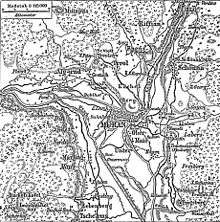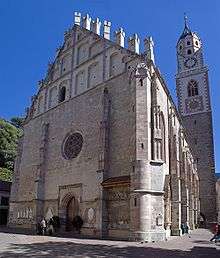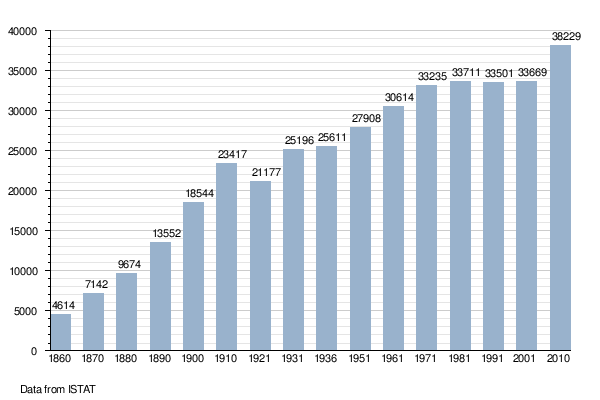Merano
| Merano Meran | ||
|---|---|---|
| Comune | ||
| Comune di Merano Stadtgemeinde Meran | ||
 | ||
| ||
 Merano Meran Location of Merano | ||
| Coordinates: 46°40′N 11°10′E / 46.667°N 11.167°ECoordinates: 46°40′N 11°10′E / 46.667°N 11.167°E | ||
| Country | Italy | |
| Region | Trentino-Alto Adige/Südtirol | |
| Province / Metropolitan city | South Tyrol (BZ) | |
| Frazioni | Altstadt (Centro), Obermais (Maia Alta), Untermais (Maia Bassa), Gratsch (Quarazze), Sinich (Sinigo), Labers | |
| Government | ||
| • Mayor | Paul Rösch | |
| Area | ||
| • Total | 26 km2 (10 sq mi) | |
| Elevation | 325 m (1,066 ft) | |
| Population (Nov. 2010) | ||
| • Total | 38,198 | |
| • Density | 1,500/km2 (3,800/sq mi) | |
| Demonym(s) | Meranese/Meraner | |
| Time zone | CET (UTC+1) | |
| • Summer (DST) | CEST (UTC+2) | |
| Postal code | 39012 | |
| Dialing code | 0473 | |
| Patron saint | St Nicholas | |
| Saint day | December 6 | |
| Website | Official website | |
Merano (Italian pronunciation: [meˈraːno] ![]() listen ) or Meran (German pronunciation: [merˈaˑn]) is a town and comune in South Tyrol, northern Italy. Generally best known for its spa resorts, it is located within a basin, surrounded by mountains standing up to 3,335 metres (10,942 feet) above sea level, at the entrance to the Passeier Valley and the Vinschgau.
listen ) or Meran (German pronunciation: [merˈaˑn]) is a town and comune in South Tyrol, northern Italy. Generally best known for its spa resorts, it is located within a basin, surrounded by mountains standing up to 3,335 metres (10,942 feet) above sea level, at the entrance to the Passeier Valley and the Vinschgau.
In the past, the town has been a popular place of residence for several scientists, literary people, and artists, including Franz Kafka, Ezra Pound, and Paul Lazarsfeld, who appreciated its mild climate.
History
Place-name
Meran is the German name for the town; Merano is the Italian name. Both are used in English. The Ladin form of the name is Maran. The official name of the municipality (comune) is Stadtgemeinde Meran in German and Comune di Merano in Italian (both are in official use).
In 17th-century Latin, the town was called Meranum.[1] Other archaic names are Mairania (from 857 AD) and an der Meran (from the 15th century).[2]
Origin


The area has been inhabited since the 3rd millennium BC, as shown by the presence of menhirs and other findings. The story of the city proper began in 15 BC when the Romans occupied the Adige valley founding a road station, Statio Maiensis.
The settlement was first mentioned in an 857 deed as Mairania. The Counts at Castle Tyrol elevated Meran to the status of a city during the 13th century and made it the capital of their County of Tyrol. After the county had been handed over to the Habsburg dynasty in 1363 upon the abdication of Margaret, Countess of Tyrol, in 1420, Duke Friedrich IV of Austria moved the Tyrolean court to Innsbruck. Though Meran remained the official capital until 1848, it subsequently lost its predominant position and almost all its importance as an economic hub across the roads connecting Italy and Germany. The important mint was also moved to Hall in 1477.
The Tyrolean Rebellion of 1809 against the French occupation drew attention again to Meran. In that year, on the Küchelberg above the city, a peasants' army eked out a victory against the united French and Bavarian forces, before their revolt was finally crushed. After World War I, under the Treaty of Saint-Germain-en-Laye Meran became part of the Kingdom of Italy with the rest of the southern part of the former Cisleithanian crown land of Tyrol.
On 12 April 2010, a train bound for Merano was hit by a mudslide 30 kilometres (19 miles) from the city between the villages of Latsch and Kastelbell. The resulting train derailment killed 9 people and injured 28; 7 of those seriously.[3][4][5]
Coat of arms
The town's coat of arms depicts the red Tyrolean eagle sitting on a wall with four pieces of Ghibelline battlements and three arches that symbolize the city. The arms is known from 14th century and the oldest seal dates from 1353, while the coloured one since 1390. In a 1759 image, the eagle is represented with a crown and a green wreath of honour. After World War I and the annexation of the town from Austria-Hungary to Italy was a new coat of arms given in 1928, which looked similar to the old one, but with five parts of the battlements and the arches with the gates opened on a lawn of shamrock. A mural crown was placed above the shield.[6] The five parts of the battlement represented the districts of Untermais, Meran (old town), Obermais, and Gratsch and Hafling, which were incorporated into the town by the Italian fascists.[7] After World War II, Hafling became independent again and the historical coat of arms was restored.[8][9]
Main sights

Among the town's landmarks are the medieval city gates such as the Vinschgauer Tor, Passeirer Tor, and the Bozener Tor. Also belonging to the fortifications is the medieval Ortenstein tower, popularly called Pulverturm (lit. "powder tower").
The main churches are the Gothic St. Nicholas' Church and the St. Barbara's Chapel, both dating to the 15th century. Also dating to this period is the Princely Castle (Landesfürstliche Burg), which was a residence of Archduke Sigismund of Austria.
The Steinerner Steg stone bridge crosses the Passer river and dates to the 17th century.
The town saw further development as it became increasingly popular as a spa resort, especially after Empress Elisabeth of Austria started visiting. Dating from the 19th century are civic theatre, the Kurhaus and the Empress Elisabeth Park. Also famous are the arched Wandelhalle promenades along the river.
After the annexation of the town to Italy in 1919, the Fascist authorities constructed the new town hall in the 1920s.
Outside the town is Trauttmansdorff Castle and its gardens. Also located there is the Museum of Tourism, which was opened in the spring of 2003 and shows the historical development of tourism in the province. Tirol Castle is also close-by.
Culture
Food
The area is well known for its wines, both white and red, and vineyards extend right into the town. The local wine, Meraner Leiten (Meranese di collina), is a light red wine, best drunk young.[10] There are also extensive orchards, and apples are exported throughout Europe. The Forst Brewery on the edge of the town produces a popular range of beers, sold throughout northern Italy.

Notable people

- Hans Andersag, (1902-1955), discovered Chloroquine, a malaria drug
- Ferdinand Behrens, painter and city portraitist to lead with authority the coat of arms of the Archduke Eugen of Austria
- Arbeo of Freising, (died 784), early medieval author and bishop
- Franciszka Arnsztajnowa, (1865-1942), poet and playwright
- Franco D'Andrea, (born 1941), jazz pianist
- Arnaldo Di Benedetto, literary critic and professor
- Ludwig Bemelmans, (1898-1962), author
- Irène Galter, (born 1931), actress
- Ferdinand Gamper, (1957-1996), serial killer
- Gloria Guida (born 1955), Italian-speaking actress
- Oswald Menghin (1888-1973), university professor, prehistorians, minister of education
- Silvius Magnago (1914-2010), former South Tyrolean provincial governor, father of the autonomy of South Tyrol
- Bargil Pixner (1921-2002), a Benedictine monk
- Leo Putz (1869-1940), Tyrolean painter
- Johann Baptista Ruffini, (1672-1749), salt trader
- Sir Rudolf Baron Slatin, Inspector General of Sudan
- Rudolf Stingel, (born 1956), artist
- Hermann von Tappeiner (1847-1927), physician and pharmacologist in Munich
- Cuno Tarfusser, (born 1954), judge at the International Criminal Court[11]
- Armin Zöggeler, (born 1974), luge champion with six Olympic medals and nine world championship golds
Economy
Tourism
Merano is a popular tourist destination especially for Germans and Italians. In summer, there are concerts on the promenade almost daily, and there are fine walks around the town and in the surrounding hills, not least "Meran 2000", where there is also skiing in winter.
Society
Population growth

Linguistic distribution
According to the 2011 census, 50.47% of the resident population spoke German as mother language, 49.06% Italian, and 0.47% Ladin.[12]
Twin towns and sister cities
The twin towns and sister cities are:
Sport
A chess opening, the Meran Variation of the Semi-Slav Defense, is named after the town, from its successful use by Akiba Rubinstein against Ernst Grünfeld during a tournament held in the town in 1924.[13] In 1981, the World Chess Championship match between Anatoly Karpov and Victor Korchnoi was held in Meran. The first act of the musical Chess also has a world chess championship match set in Meran, and features a song entitled "Merano", which includes the line, "rosy-cheeked Merano, flourishing to a fault".
The city's handball team is one of the most successful in Italy, winner of the scudetto in 2005. The ice hockey team won two national championships, but it is currently playing in the Second Division (A2 series).
Each September, the Gran Premio Merano takes place in the Maia Racecourse; this is the most famous Italian Steeplechase.
Merano hosted the 1953, 1971 and 1983 ICF Canoe Slalom World Championships. This is where the well known 'Merano' move was created due to a tricky upstream gate. This move is now used and well known by many slalom paddlers globally.
Cultural reference
In the musical Chess by Tim Rice, Benny Andersson and Björn Ulvaeus, the world chess championship takes place in Merano, which is also the name of the opening song of the musical's original 1984 concept album.[14]
Notes and references
- ↑ Johann Jacob Hofmann, Lexicon Universale (1698), lemma 'Tirolis'
- ↑ Egon Kühebacher, Die Ortsnamen Südtirols, Vol. 1 (2000), lemma Meran
- ↑ "Fahrt in den Tod für junge Mutter – Trauerfeier in Schlanders / Lokal / Chronik im Überblick / Artikel / Home - stol.it - Suedtirol Online mit Nachrichten, Bildern und Videos" (in German). stol.it. Retrieved 2013-03-26.
- ↑ "Landslide derails train in Italy leaving nine dead". BBC News. 2010-04-12. Retrieved 2014-06-17.
- ↑ "At least six killed in train crash - News in English". ANSA.it. Retrieved 2013-03-26.
- ↑ Ralf Hartemink (1996). "Meran - Merano". Heraldry of the World. Retrieved 17 June 2011.
- ↑ Gryffindor (2011). "Image of the coat of arms during the Italian fascist period". Wikimedia Commons. Retrieved 17 June 2011.
- ↑ Prünster, Hans (1972). Die Wappen der Gemeinden Südtirols [The coat of arms of the municipalities of South Tyrol]. Etschlandbücher (in German). 7. Bozen: Landesverband für Heimatpflege in Südtirol.
- ↑ Gall, Franz (1960). Österreichischer Wappenkalender (in German).
- ↑ Hugh Johnson's Pocket Wine Book 2006
- ↑ Biography of Judge Cuno Jakob TARFUSSER Archived June 27, 2009, at the Wayback Machine.
- ↑ "Volkszählung 2011/Censimento della popolazione 2011". astat info. Provincial Statistics Institute of the Autonomous Province of South Tyrol (38): 6–7. June 2012. Retrieved 2012-06-14.
- ↑ "An Opening Created in 1924 Still Leads to Complex Battles", New York Times , 29 January 2006
- ↑ "Chess". AllMusic.
Further reading
- Norddeutscher Lloyd (1896), "Meran", Guide through Germany, Austria-Hungary, Italy, Switzerland, France, Belgium, Holland and England, Berlin: J. Reichmann & Cantor, OCLC 8395555
External links
| Wikimedia Commons has media related to Meran. |
-
 Merano travel guide from Wikivoyage
Merano travel guide from Wikivoyage - Official website
- Meran.eu, Homepage of the Tourism Authority

